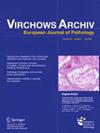Ekaterina Bazyleva, Lotte E van der Meeren, Mirthe H Schoots, Linda M Ernst, T Yee Khong, Neil J Sebire, Paul Seegers, Sanne J Gordijn
求助PDF
{"title":"The Amsterdam Criteria and beyond: development of a Standardized Structured Reporting (SSR) tool for diagnosis of placental pathology.","authors":"Ekaterina Bazyleva, Lotte E van der Meeren, Mirthe H Schoots, Linda M Ernst, T Yee Khong, Neil J Sebire, Paul Seegers, Sanne J Gordijn","doi":"10.1007/s00428-025-04143-0","DOIUrl":null,"url":null,"abstract":"<p><p>The lack of standardized reporting in placental pathology limits research scalability and clinical application despite consensus-based criteria like the Amsterdam Criteria. This study presents the development and implementation of a comprehensive Standardized Structured Reporting (SSR) tool for placental pathology. Utilizing the LogicNets© platform, the tool incorporates the Amsterdam Criteria, Freedman placental phenotype classification system, and consensus recommendations on placental examination. Development involved collaboration with placental pathology experts, literature review, and iterative feedback from pathologists to address reporting inconsistencies and ensure practicality. The SSR tool integrates evidence-based standards for examining and phenotyping the placenta, including structured gross and microscopic analyses. It introduces control mechanisms for severity grading and phenotype assignment, enabling precise assessment of placental lesions, even in multiple births. Organized into sections-Demographics, Macroscopy, Microscopy, and Group and Phenotype-it efficiently records and analyzes data. Additional functionalities include automated calculations of gross placental features, built-in controls, and versatile documentation of microscopic observations. The tool is designed for seamless integration into clinical workflows. Implementing the SSR tool could enhance placental pathology reporting quality, completeness, and consistency, facilitating large-scale analyses. Discrete data capture enables robust research, potentially improving the clinical utility and understanding of placenta-mediated diseases. However, further validation is required before widespread adoption. Embracing SSR could standardize placental examination, improve clinical interpretation, and advance research in placental pathology for enhanced utility in both research and clinical care.</p>","PeriodicalId":23514,"journal":{"name":"Virchows Archiv","volume":" ","pages":""},"PeriodicalIF":3.1000,"publicationDate":"2025-06-18","publicationTypes":"Journal Article","fieldsOfStudy":null,"isOpenAccess":false,"openAccessPdf":"","citationCount":"0","resultStr":null,"platform":"Semanticscholar","paperid":null,"PeriodicalName":"Virchows Archiv","FirstCategoryId":"3","ListUrlMain":"https://doi.org/10.1007/s00428-025-04143-0","RegionNum":3,"RegionCategory":"医学","ArticlePicture":[],"TitleCN":null,"AbstractTextCN":null,"PMCID":null,"EPubDate":"","PubModel":"","JCR":"Q1","JCRName":"PATHOLOGY","Score":null,"Total":0}
引用次数: 0
引用
批量引用
Abstract
The lack of standardized reporting in placental pathology limits research scalability and clinical application despite consensus-based criteria like the Amsterdam Criteria. This study presents the development and implementation of a comprehensive Standardized Structured Reporting (SSR) tool for placental pathology. Utilizing the LogicNets© platform, the tool incorporates the Amsterdam Criteria, Freedman placental phenotype classification system, and consensus recommendations on placental examination. Development involved collaboration with placental pathology experts, literature review, and iterative feedback from pathologists to address reporting inconsistencies and ensure practicality. The SSR tool integrates evidence-based standards for examining and phenotyping the placenta, including structured gross and microscopic analyses. It introduces control mechanisms for severity grading and phenotype assignment, enabling precise assessment of placental lesions, even in multiple births. Organized into sections-Demographics, Macroscopy, Microscopy, and Group and Phenotype-it efficiently records and analyzes data. Additional functionalities include automated calculations of gross placental features, built-in controls, and versatile documentation of microscopic observations. The tool is designed for seamless integration into clinical workflows. Implementing the SSR tool could enhance placental pathology reporting quality, completeness, and consistency, facilitating large-scale analyses. Discrete data capture enables robust research, potentially improving the clinical utility and understanding of placenta-mediated diseases. However, further validation is required before widespread adoption. Embracing SSR could standardize placental examination, improve clinical interpretation, and advance research in placental pathology for enhanced utility in both research and clinical care.
阿姆斯特丹标准和超越:一个标准化的结构化报告(SSR)工具的发展,用于诊断胎盘病理。
尽管有阿姆斯特丹标准等基于共识的标准,但胎盘病理学缺乏标准化报告限制了研究的可扩展性和临床应用。本研究提出了一个全面的标准化结构化报告(SSR)工具胎盘病理的发展和实施。利用LogicNets©平台,该工具结合了阿姆斯特丹标准、弗里德曼胎盘表型分类系统和胎盘检查的共识建议。开发过程涉及与胎盘病理学专家的合作、文献回顾和病理学家的反复反馈,以解决报告的不一致并确保实用性。SSR工具整合了以证据为基础的标准,用于检查和分型胎盘,包括结构化的肉眼和显微镜分析。它引入了严重程度分级和表型分配的控制机制,使胎盘病变的精确评估,甚至在多胞胎。组织成部分-人口统计,宏观,显微镜,和组和表型-它有效地记录和分析数据。其他功能包括自动计算总胎盘特征,内置控制,和显微观察的多功能文档。该工具旨在无缝集成到临床工作流程中。实施SSR工具可以提高胎盘病理报告的质量、完整性和一致性,便于大规模分析。离散数据捕获使稳健的研究,潜在地提高临床效用和理解胎盘介导的疾病。然而,在广泛采用之前还需要进一步的验证。采用SSR可以规范胎盘检查,改善临床解释,推进胎盘病理学研究,提高研究和临床护理的实用性。
本文章由计算机程序翻译,如有差异,请以英文原文为准。

 求助内容:
求助内容: 应助结果提醒方式:
应助结果提醒方式:


